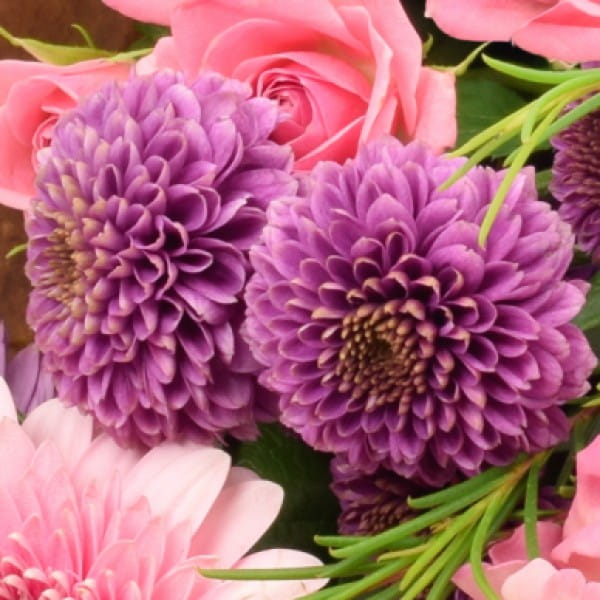Author: Peter Karper
These points are covered in this article and explained to you in more detail:
- Origin of the name
- Flowering time of the chrysanthemum
- Occurrence and distribution
- Characteristics of chrysanthemums
- Message and meaning of chrysanthemums
- Care guide for chrysanthemums
- Occasions for sending chrysanthemums
- Card text templates for sending
Origin of the name
The chrysanthemum, also known by the scientific name Chrysanthemum, belongs to the genus Chrysanthemum within the Asteraceae family. The name is derived from the Greek and means "golden flower", which refers to the original golden colour of many varieties. This ornamental plant was mainly cultivated in East Asia and is now one of the most important ornamental plants worldwide.
When chrysanthemums bloom: When do chrysanthemums bloom?
Depending on the variety, chrysanthemums flower from late summer until well into autumn. The flowering period is one of the most attractive characteristics of this plant, as it flowers at a time when many other plants have already faded. Autumn chrysanthemums in particular, also known as winter asters, extend the flowering season and bring colour to the autumn garden. Chrysanthemums often bloom until the first frost, ensuring a long-lasting blaze of colour in the garden.

Occurrence and distribution of chrysanthemums
Chrysanthemums, especially Chrysanthemum indicum, are mainly native to East Asia and have been cultivated there for centuries. Nowadays, they are widespread throughout the world and can be found in many gardens. They thrive in nutrient-rich and well-drained soil and prefer a sunny to semi-shady location. Garden chrysanthemums are particularly adaptable and are suitable for both beds and pots.
Characteristics of chrysanthemums: Genus, varieties and flowering
The chrysanthemum is a perennial shrub with a wide range of varieties. Depending on the species, the plant can reach different heights and develop different flower shapes and colours. The double flowers are particularly popular and the plants are ideal for growing in beds or pots. Chrysanthemums are hardy perennials, but there are also frost-sensitive varieties that require special protection. The hardy garden chrysanthemums in particular are ideal for growing outdoors. The lower leaves should always be kept moist to ensure the health of the plant.
The message and meaning of chrysanthemums
Chrysanthemums are deeply symbolic in many cultures. In East Asia they stand for long life and happiness, while in Europe they are often associated with autumn and transience. A bouquet of chrysanthemums is an ideal greeting for a loved one and makes a perfect gift. Especially during the chrysanthemum season, when these colourful plants are in full bloom, they are a popular choice for special occasions.
Planting chrysanthemums: The right location and care for autumn chrysanthemums
Planting chrysanthemums is not difficult, but there are a few points to bear in mind to get the best out of your plants. They prefer a sunny to semi-shady location and a nutrient-rich, well-drained potting soil. Make sure that the soil is not too wet to avoid waterlogging. Autumn chrysanthemums are particularly robust and are well suited for planting in beds and pots. They are hardy and require little care to provide long-lasting enjoyment.
Chrysanthemums in beds and pots: tips for successful planting
Chrysanthemums in beds need sufficient space so that their shoots can develop well. When planting in a pot, it is important to use high-quality potting soil and ensure good drainage. Planting chrysanthemums in the garden is an excellent way to create colourful accents. Make sure that the plants are best planted in spring or autumn. Potted chrysanthemums are ideal for balconies and patios and can also thrive wonderfully in containers.
Fertilise and prune chrysanthemums correctly: How to care for your plants
Fertilising chrysanthemums is particularly important during the growth phase. Use a special fertiliser to prolong the flowering period and promote strong shoots. After the flowering period, wilted flowers and shoots close to the ground should be removed to keep the plant healthy. Pruning before overwintering helps to prepare the plants for the cold season.
Overwintering chrysanthemums: protection for the cold season
Winter-hardy chrysanthemums can remain in the bed, while frost-sensitive varieties are better off overwintering in a pot. To overwinter chrysanthemums, we recommend using fir branches or other protective material to protect the plants from frost. Potted chrysanthemums should overwinter in a frost-free location.
Propagate cuttings: How to propagate chrysanthemums successfully
Chrysanthemums can be easily propagated by cuttings. This method is particularly suitable for obtaining new plants for the garden. Cuttings should be cut in spring and planted in nutrient-rich soil. Make sure that the cuttings are kept moist to ensure good rooting.
Special varieties and species of chrysanthemums
There are over 40 species and many different varieties of chrysanthemum, which differ in shape, colour and flowering time. Some special varieties flower later in the year, while others are known for their double flowers. The Chrysanthemum genus offers an incredible variety that can enrich any garden.
Occasions for sending chrysanthemums
Chrysanthemums make excellent gifts for a variety of occasions. Whether as a birthday bouquet, an autumnal decoration or a funeral wreath - chrysanthemums are versatile. Thanks to their long flowering period and the wide variety of colours and shapes, they are an ideal flower greeting that always brings joy. Garden chrysanthemums are particularly popular as they are hardy and can be enjoyed outdoors for a long time.
Card text templates to send
- For a loved one: "May this bouquet of chrysanthemums bring you joy and colour in autumn. All my love, [your name]."
- For a birthday: "Happy birthday! These chrysanthemums should bring a smile to your face. All the best, [your name]."
- For special occasions: "I send you my best wishes with these colourful chrysanthemums. May they accompany you on beautiful days. Best wishes, [your name]."
Discover more types of flowers in our encyclopaedia
Delve deeper into the world of flowers and find out more about their meaning, care and origin:
*Note: If you click on a link that corresponds to the current page, the page will be reloaded.

